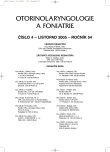Anomalous Course of Internal Carotid Artery as a Cause of Massive Perioperative Hemorrhage from Middle Ear
Anomální průběh arteria carotis interna jako příčina masivní peroperační hemoragie ze středouší
Souhrn:
Masivní krvácení při středoušních operacích se vyskytuje naštěstí velmi vzácně. Autoři prezentují kazuistiku pacienta, operovaného pro suspektní mesotympanický chemodektom. V průběhu operace došlo k prudkému arteriálnímu krvácení ze středouší, které bylo zastaveno pevnou tamponádou zvukovodu a nosohltanu. Následná angiografie ukázala, že šlo o krvácení z a. carotis interna anomálně probíhající středouším. Vzniklé pseudoaneurysma tepny ve středouší bylo jedenáctý den po operaci ošetřeno endovaskulárně superselektivní embolizací spirálkami. V druhé době byl bubínek zpevněn chrupavčitým transplantátem. Pacient se zhojil bez jakýchkoliv zdravotních následků, přetrvává pouze převodní nedoslýchavost pravého ucha. Autoři připomínají vývoj tepenného zásobení středouší a vznik nejvýznamnějších cévních anomálií středního ucha, kterými jsou perzistující stapedeální artérie a aberantní artérie carotis interna. Zdůrazňují, že pro včasnou diagnózu této anomálie je rozhodující selektivní angiografie (DSA) a. carotis a HRCT spánkové kosti posouzené otologickým rentgenovým specialistou.
Klíčová slova:
aberantní a. carotis interna, masivní krvácení ze středouší, anomálie průběhu a. carotis interna, iatrogenní poranění a. carotis interna.
Authors:
J. Valvoda; M. Hroboň
Authors‘ workplace:
Otorinolaryngologické oddělení VFN, Praha
přednosta doc. MUDr. M. Hroboň, CSc.
Published in:
Otorinolaryngol Foniatr, 54, 2005, No. 4, pp. 211-217.
Category:
Case History
Overview
Summary:
Massive intraoperative hemorrhage during middle ear surgery is unusually rare. The authors describe a case report of the patient operated on suspected glomus tumor. During surgery a significant arterial bleeding occurred when a probatory excision from the suspected tumor had been taken. It was stopped by firm gauze plugging of the external ear canal and nasopharynx. Subsequent angiography showed the anomalous internal carotide artery traversing the middle ear to be a source of bleeding. A pseudoaneurysm of internal carotid artery developed in the middle ear. It was treated by superselective endovascular embolization with coils eleven days after accident. In second stage the tympanic membrane was strengthened by chondroperichondral graft. The patient healed without sequelae. There is only moderate conductive hearing loss on the operated side. The authors submit an overview of the arterial supply of the middle ear, its embryologic development as well as formation of the most important vascular anomalies of the middler ear, namely persistent stapedial artery and abberant internal carotid artery. They stress the meaning of the selective angiography (DSA) of the internal carotid artery and HRCT of the temporal bone evaluated by otologically specialized radiographer.
Key words:
aberrant internal carotid artery, massive hemorrhage from the middle ear, anomalous course of the carotid artery, iatrogenic injury of the internal carotid artery.
Labels
Audiology Paediatric ENT ENT (Otorhinolaryngology)Article was published in
Otorhinolaryngology and Phoniatrics

2005 Issue 4
Most read in this issue
- Xerostomia: Etiology, Therapeutic Possibilities, Recommendation to Patients
- Shaver (Microdebrider) in Otorhinolaryngology
- Langerhans‘ Cell Histiocytosis and Its Manifestation in Temporal Bone (Eosinophilic Granuloma of the Temopral Bone)
- Cholesteatoma and Fistula of Bone Labyrinth
